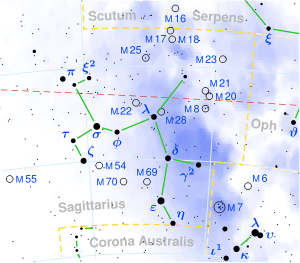21 Sagittarii
| Observation data Epoch J2000 Equinox J2000 | |
|---|---|
| Constellation | Sagittarius |
| Right ascension | 18h 25m 21.04075s[1] |
| Declination | −20° 32′ 30.0385″[1] |
| Apparent magnitude (V) | 4.81[2] |
| Characteristics | |
| Spectral type | K2II+A5[3][4] |
| U−B color index | +0.93[5] |
| B−V color index | +1.30[5] |
| Astrometry | |
| Radial velocity (Rv) | -11.80[6] km/s |
| Proper motion (μ) | RA: +8.46[1] mas/yr Dec.: -28.07[1] mas/yr |
| Parallax (π) | 7.95 ± 0.72[1] mas |
| Distance | 410 ± 40 ly (130 ± 10 pc) |
| Absolute magnitude (MV) | -0.67[2] |
| Details | |
| Mass | 7.9[7] M☉ |
| Luminosity | 320[2] L☉ |
| Temperature | 4,234[8] K |
| Rotational velocity (v sin i) | 4.4[9] km/s |
| Other designations | |
| Database references | |
| SIMBAD | data |
21 Sagittarii (21 Sgr) is a class K2II[3] (orange bright giant) star in the constellation Sagittarius. Its apparent magnitude is 4.81[2] and it is approximately 410 light years away based on parallax.[1]
It has one companion, B, at separation 1.7" and magnitude 7.43, with type reported as A5.[10][4]
References
- 1 2 3 4 5 6 Van Leeuwen, F. (2007). "Validation of the new Hipparcos reduction". Astronomy and Astrophysics. 474 (2): 653. arXiv:0708.1752. Bibcode:2007A&A...474..653V. doi:10.1051/0004-6361:20078357. Vizier catalog entry
- 1 2 3 4 Anderson, E.; Francis, Ch. (2012). "XHIP: An extended hipparcos compilation". Astronomy Letters. 38 (5): 331. arXiv:1108.4971. Bibcode:2012AstL...38..331A. doi:10.1134/S1063773712050015. Vizier catalog entry
- 1 2 Hoffleit, D.; Warren, W. H. (1995). "VizieR Online Data Catalog: Bright Star Catalogue, 5th Revised Ed. (Hoffleit+, 1991)". VizieR On-line Data Catalog: V/50. Originally published in: 1964BS....C......0H. 5050. Bibcode:1995yCat.5050....0H.
- 1 2 Eggleton, P. P.; Tokovinin, A. A. (2008). "A catalogue of multiplicity among bright stellar systems". Monthly Notices of the Royal Astronomical Society. 389 (2): 869. arXiv:0806.2878. Bibcode:2008MNRAS.389..869E. doi:10.1111/j.1365-2966.2008.13596.x. Vizier catalog entry
- 1 2 Mallama, A. (2014). "Sloan Magnitudes for the Brightest Stars". The Journal of the American Association of Variable Star Observers. 42: 443. Bibcode:2014JAVSO..42..443M. Vizier catalog entry
- ↑ Gontcharov, G. A. (2006). "Pulkovo Compilation of Radial Velocities for 35 495 Hipparcos stars in a common system". Astronomy Letters. 32 (11): 759. arXiv:1606.08053. Bibcode:2006AstL...32..759G. doi:10.1134/S1063773706110065.
- ↑ Tetzlaff, N.; Neuhäuser, R.; Hohle, M. M. (2011). "A catalogue of young runaway Hipparcos stars within 3 kpc from the Sun". Monthly Notices of the Royal Astronomical Society. 410: 190. arXiv:1007.4883. Bibcode:2011MNRAS.410..190T. doi:10.1111/j.1365-2966.2010.17434.x. Vizier catalog entry
- ↑ McDonald, I.; Zijlstra, A. A.; Boyer, M. L. (2012). "Fundamental parameters and infrared excesses of Hipparcos stars". Monthly Notices of the Royal Astronomical Society. 427: 343. arXiv:1208.2037. Bibcode:2012MNRAS.427..343M. doi:10.1111/j.1365-2966.2012.21873.x. Vizier catalog entry
- ↑ Glebocki, R.; Gnacinski, P. (2005). "VizieR Online Data Catalog: Catalog of Stellar Rotational Velocities (Glebocki+ 2005)". VizieR On-line Data Catalog: III/244. Originally published in: 2005csss...13..571G; 2005yCat.3244....0G. 3244. Bibcode:2005yCat.3244....0G. Vizier catalog entry
- ↑ Mason, Brian D.; Wycoff, Gary L.; Hartkopf, William I.; Douglass, Geoffrey G.; Worley, Charles E. (2001). "The 2001 US Naval Observatory Double Star CD-ROM. I. The Washington Double Star Catalog". The Astronomical Journal. 122 (6): 3466. Bibcode:2001AJ....122.3466M. doi:10.1086/323920. Vizier catalog entry
This article is issued from
Wikipedia.
The text is licensed under Creative Commons - Attribution - Sharealike.
Additional terms may apply for the media files.
